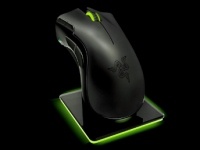Review: Razer Mamba | TechTree.com
Review: Razer Mamba
It's back to the drawing board for Razer.

Virtually lag-free wireless interface; Great balance between ergonomics and agility; Freedom to choose between wired and wireless modes; Can use the mouse while charging; Custom lighting effects; Great UI.
Expensive; Suffers from jitter; DPI-scaling kills accuracy; Dual-sensors don't improve tracking; Surface calibration is useless; Picky about surfaces; Variable cut-off distance doesn't work; Power hungry; Long charging time; Settings take aeons to apply.
Review: Razer Mamba
MRP: Rs 8000
Street Price: Rs 5900 (Lynx-India.com); Rs 6600 (Flipkart.com)
Even after my Razer DeathAdder (DA) curled up and died a week after its one-year warranty expired, there seemed to be no reason why I shouldn't have bought another one. That's because, for the money, nothing can match the the DA in terms of performance. Coincidentally, around the same time, Razer released a pimped-up version of the Mamba. In simple terms, it's the DA sans the wires and with extra infrared optics shoved in along with the existing laser sensor. The 4G dual-sensor system should ideally rid the Mamba of its wired cousin's incompatibility with all but the best gaming-grade surfaces. The hybrid laser-IR optics are also touted to enable custom sensor cut-off distances for better lift-off accuracy.

The Mamba looks downright stunning.
In short, if Razer gets it right, the Mamba could turn out to be the epitome of a perfect mouse. For me, that's good enough to consider shelling over Rs 6000 for it. Needless to say, I called in a review sample to check if the Mamba performs as well as it does on paper.
A DeathAdder Without The Wires
If you've seen the DA, you've seen the Mamba. The latter is slightly heavier due to its 1100 mAh Li-ion rechargeable battery. However, the added weight isn't significant enough to affect handling. While the DA bears a single resolution (dpi) switch at the bottom, the Mamba sports two tiny switches along the edge of the left mouse button that allow you to cycle quickly through resolution presets. These are a godsend when you want to switch from a sniper rifle to a submachine gun, for example. The left \ right buttons and thumb-switches at the sides bear palpably better tactile feedback than the DA, which bore pretty awesome mechanical switches to begin with.

The tiny dpi-switch buttons allow you to rapidly cycle through preset resolutions.
The bottom of the Mamba is populated with a button to establish a wireless connection, an on\off switch to select between wired and wireless operation, and a slider lock to release the gold-plated USB cable. The battery compartment lies right below the 4G sensor system. A pair of gold contacts lets you charge the battery by placing the mouse on the dock. A spring-loaded locking mechanism ensures that even the most violent pulls cannot accidentally yank out the USB cable. In wireless mode, the USB cable connects the PC to the dock \ receiver, whereas in wired mode it connects directly to the mouse and charges its battery as well.

The detachable cord allows you to recharge the battery as you play.
The wheel has a pronounced notchy feedback, which is good for cycling though weapons, but not ideal for browsing websites. It is also the only illuminated part of the mouse. This uncharacteristic restraint on the light show is clearly for the sake of a better battery life. The power reserve is indicated by three vertical bars along the left edge of the mouse. Despite the 1100 mAh battery, the Mamba claims to deliver only 16 hours of continuous usage. This held up true since the mouse generally lasted two 8-hour shifts before going completely flat. However, you are better off recharging when the power level is down to one bar, after which the mouse starts to track erratically.

The 1100 mAh battery won't last over two days of heavy use.
The UI is neat, efficient, and comprehensive enough to allow standard resolution, sensitivity, and polling rate adjustments, along with advanced functions such as setting the sensor cut-off distance and a custom multi-colour LED illumination setup. The driver suite, however, takes aeons to apply the settings. This isn't just a minor inconvenience, but an excruciatingly long wait that will make you dread the very thought of modifying any settings.
Far From Perfect
The mouse is far from perfect out of the box. However, most of the defects have been addressed through firmware updates, which makes them indispensable. Even with the updated driver and firmware, I experienced a deal-breaking issue with the mouse sensitivity in both wired and wireless modes. No matter what resolution I set the 6400 dpi Mamba to, fine mouse inputs felt vague and imprecise. This made it impossible to track far-off targets with Quake III's Lightning Gun or the secondary fire of the Pulse Gun from Unreal Tournament, for example.

With the wire attached, the Mamba is a dead ringer for the DeathAdder.
How bad is that, you ask? Well, the Mamba's inability to precisely lead shots with the Plasma Gun across large distances got my ass whupped in Q3. In contrast, the DeathAdder allowed me to dominate the game with the same arena and bots, at the same Hardcore difficulty. This can be attributed to the Dynamic DPI Scaling or other equally terrible driver hacks implemented by Razer, after users discovered low-speed jitter and tracking issues while making fine adjustments in the wireless mode.
Just as I had expected, uninstalling the driver fixed the sensitivity problem. However, doing so brought back the tracking issues "fixed" by the driver. This left me with two uncomfortable options: (1) Install the driver to fix the low-speed jitter, but ruin everything with dynamic sensitivity scaling. (2) Don't install the drivers at all for flawless performance in the wired mode, but lose the ability to use a 1000 Hz polling rate and fine-tune the mouse. Worse, the low-speed jitter made the mouse unusable in the wireless mode.
Ironically then, there is no way to use this "wireless mouse" in the wireless mode. One thing is for certain though: installing the driver renders the Mamba practically useless. Wired and without the driver is the only way to go then. It is utterly pointless to have to compromise this way for something that costs well over six grand.

The recessed USB port has a wire locking mechanism to prevent accidental detachment.
The DeathAdder still reigns over Razer's current crop of laser mice because it isn't outfitted with the much-reviled Philips Twin-Eye (PTE) Laser sensors. That's why the DA can track true on both hard as well as soft surfaces. The PTE laser sensor makes most new Razer mice run erratically on soft surfaces, while also causing lift-off gremlins. The new 4G Mamba's extra optical sensor was supposed to solve this problem.
The real-world performance, however, tells a different story altogether. The lift-off distance is still way too high and continues to make the mouse cursor shift positions during the exercise. Adjusting the sensor cut-off distance through the driver makes absolutely no difference to the lift-off height, while the automatic surface calibration fails to improve accuracy. Razer's 4G sensor then simply doesn't fix the Z-axis tracking issues that have plagued its earlier 3G and 3.5G laser sensors.
Back To The Drawing Board
In short, the Razer Mamba utterly fails to make a case for itself. This is a pity because when it did work, the wireless mode seemed virtually lag-fee and just as competent as its wired counterpart. In effect, it's best to stick with wired mice for gaming.
If you seek a good all-round mouse, the DeathAdder still remains your best bet. However, if you have money to burn, the awesome Roccat Kone [+] is the one to go for. This puppy has a surface calibration mode and lift-off distance adjustment feature that actually works, while delivering pinpoint accuracy — for a price, of course. I guess it's back to the drawing board for Razer then.
Performance: 1/5
Design And Build Quality: 4/5
Features: 4.5/5
Value: 1/5
Mojo: 2/5
Overall Rating: 2.5/5
TAGS: Gaming, Input Devices, Razer, Nachiket
- DRIFE Begins Operations in Namma Bengaluru
- Sevenaire launches ‘NEPTUNE’ – 24W Portable Speaker with RGB LED Lights
- Inbase launches ‘Urban Q1 Pro’ TWS Earbuds with Smart Touch control in India
- Airtel announces Rs 6000 cashback on purchase of smartphones from leading brands
- 78% of Indians are saving to spend during the festive season and 72% will splurge on gadgets & electronics
- 5 Tips For Buying A TV This Festive Season
- Facebook launches its largest creator education program in India
- 5 educational tech toys for young and aspiring engineers
- Mid-range smartphones emerge as customer favourites this festive season, reveals Amazon survey
- COLORFUL Launches Onebot M24A1 AIO PC for Professionals







TECHTREE